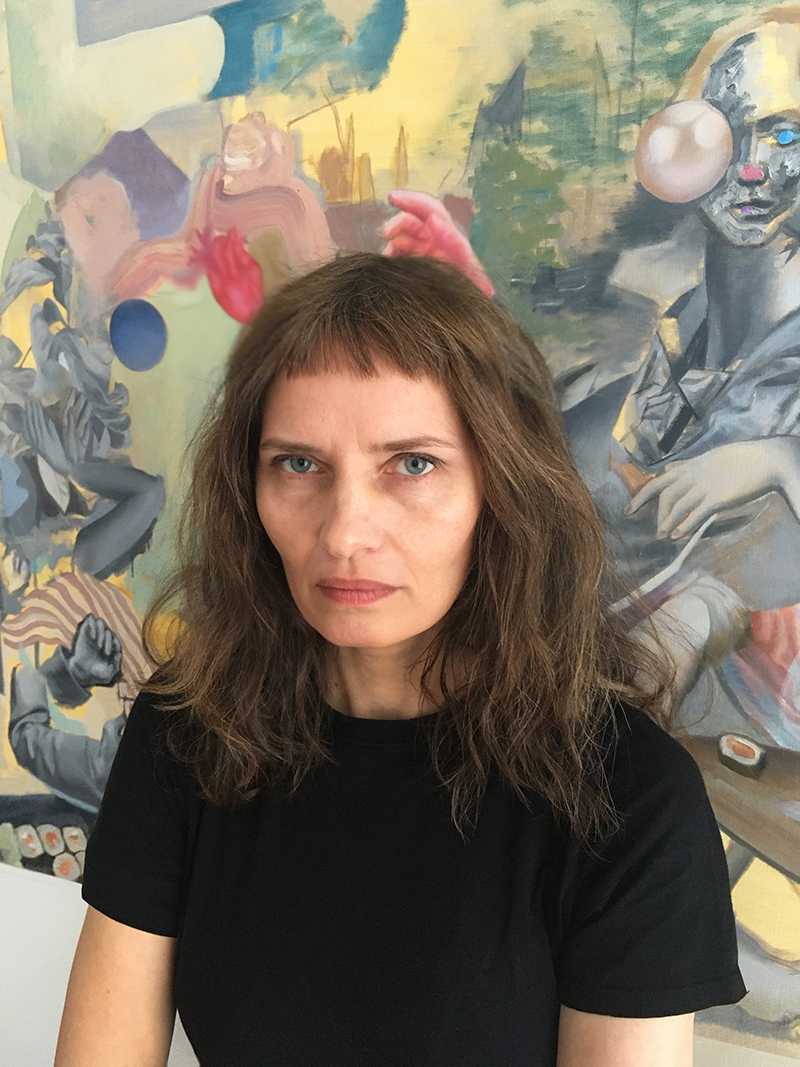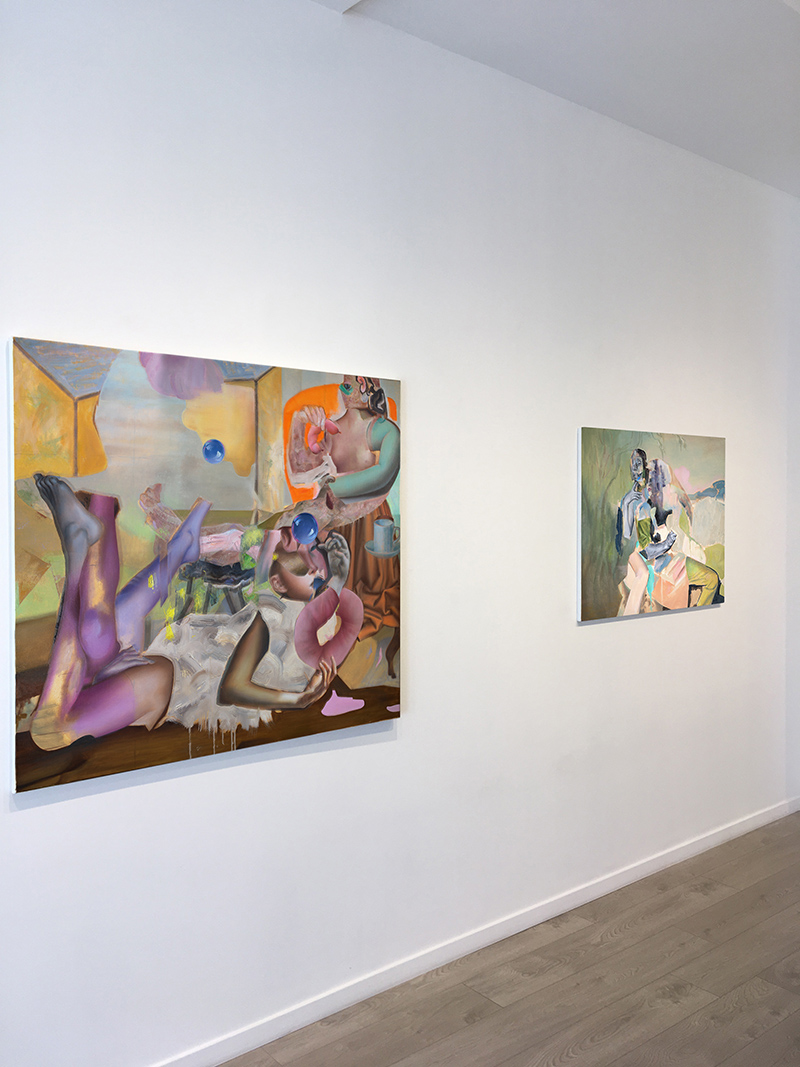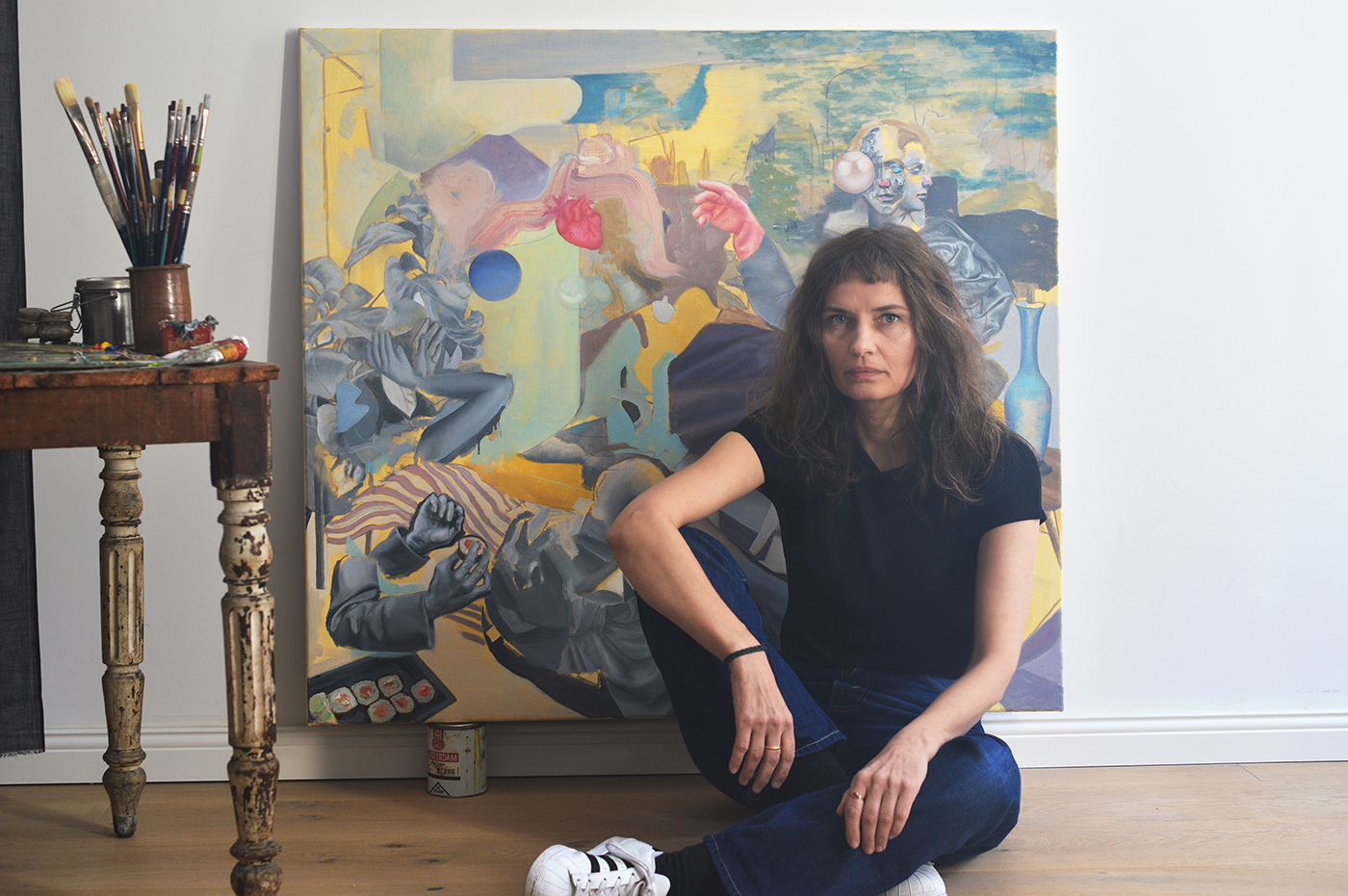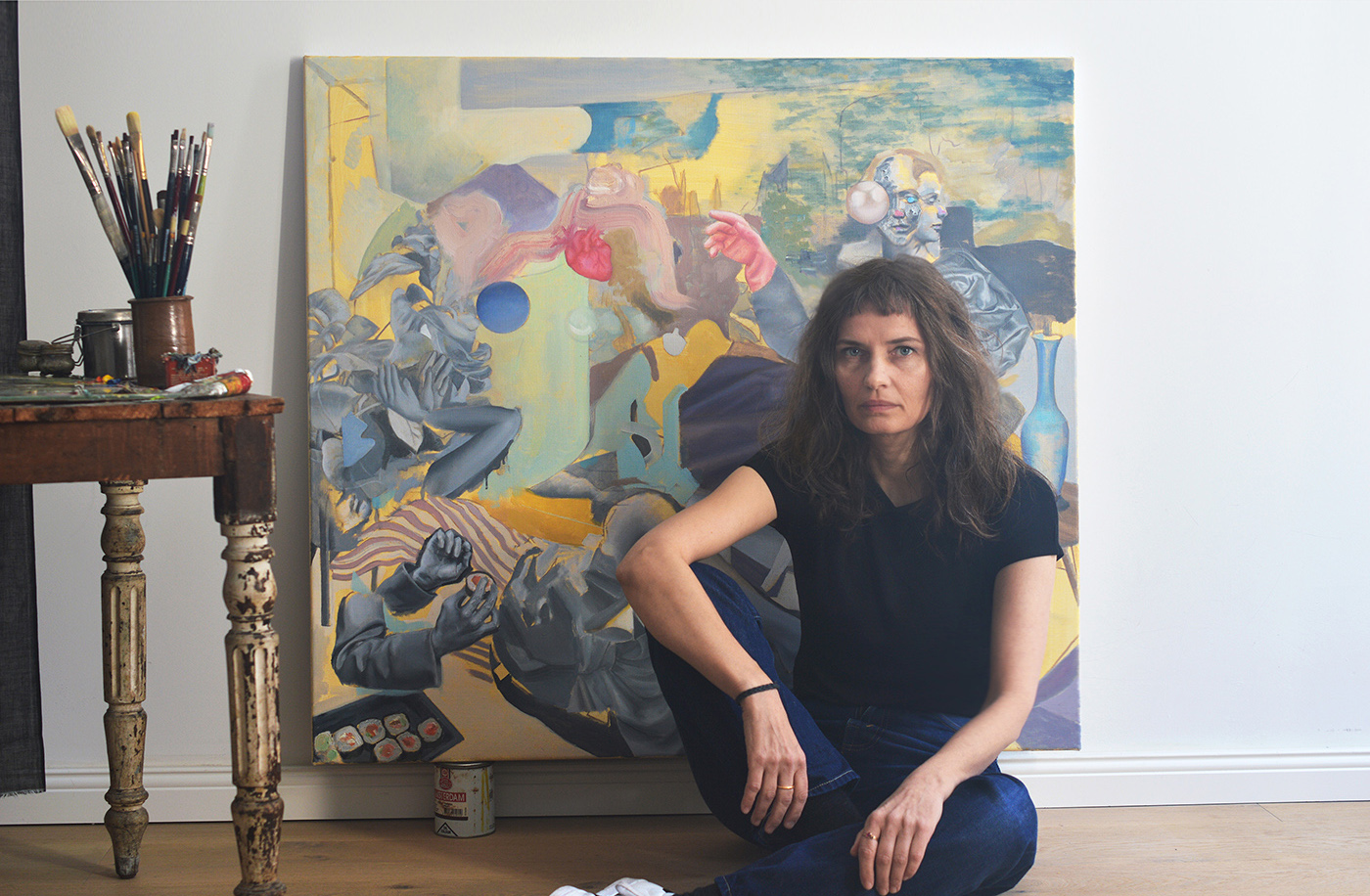Contemporary artist Kirstine Reiner Hansen took the plunge, and changed her style at the risk of losing collectors and galleries. She talks about her motivations and process in an interview with Anjali Singh.
I like to think that maybe the viewer subconsciously feels a sense of recognition, because of the known fragments, while at the same time it is new and strange.
Contemporary artist Kirstine Reiner Hansen
Featured image and below: Artist portrait courtesy contemporary artist Kirstine Reiner Hansen

Contemporary artist Kirstine Reiner Hansen
Please tell us a little about yourself, what brought you to the world of contemporary art and how did you start?
I was always drawing as a child, it was very natural. I’m sure everybody says that! My parents would throw me paper and a pencil and I’d be happily occupied for hours. In fact any creative project would have me intensely focused. As a young adult, I think I thought of myself as an artist, but was worried I couldn’t make a living, so I chose a BA in illustration and graphic design at Kolding School of Design in Denmark. After graduation the employment opportunities were generally quite dismal, so it seemed just as well to start following my real inclination to paint.
My aim is that the viewers feel as excited as I felt while creating it, like a transfer of emotional states.
How do you describe yourself in the context of challenging people’s perspectives via your work and art?
When people experience quite different things and come to surprising conclusions about the meaning of the work, that’s when I feel I really succeeded, even if it’s far from my own intentions. I would hate to ascribe a specific meaning to the narratives. It needs to be open-ended enough for the viewer to access it on their own. My aim is that the viewers feel as excited as I felt creating it, like a transfer of emotional states.
How do you deal with the conceptual difficulty and uncertainty of creating new work?
It can be daunting to start a new body of work, because you always want to go somewhere new with your practice, and you don’t want to repeat yourself. But as you’re pulled into the work, pressure fades away and new ideas and concepts take over. To me discipline and work is key.

Exhibition view. Contemporary artist Kirstine Reiner Hansen
My style could be called ‘disrupted realism’, which is a term coined by the author John Seed, who wrote a book about it.
Let’s talk about the evolution of your practice over the years. Tell us about your commitment to your current medium. What would you call your style?
I guess my style could be called ‘disrupted realism’, which is a term coined by the author John Seed, who wrote a book about it. I came to this expression because I wanted to retain elements of my previous style, classical realism, in the form of sampled found elements from historical paintings that I feel a connection to, have it clash and fuse with imagery from fashion, advertising and old Hollywood. I like to think that maybe the viewer subconsciously feels a sense of recognition, because of the known fragments, while at the same time it is new and strange.
The biggest thrill is the point in the process when the painting seems like it has always existed.
Let’s talk about your frameworks, references and process. What inspires you?
With the distorted figures and narratives, I seek to draw parallels between contemporary advertisements and the representation of wealth, beauty and status in art history. I use digital collage as a tool to start the process, which allows me to create surprising juxtapositions, drawing from a more subconscious level. I’ve been using Photoshop for a long time, so working in many layers (sometimes over a hundred) is second nature to me. It can take a really long time before the collage has matured enough. This first phase of the process familiarises me with the image and the idea before I start a painting, which I really like.
The next phase is painting with oil on canvas using the collage as a reference. Later in the process, I focus on the painting by itself and from there I try to ‘glue’ it all together. I still use some of the old masters’ techniques, like underpainting in monochrome and glazes. I also like to make my own oil paints from pigments. Working in phases, steps and layers, allows me to go deeper into the image and to make constant decisions. The mess of styles and pieces presents the challenge of making it all work together in a puzzle-like process, which I find an immensely interesting .
Creating these fragmented pieces of simulacrum as a kind of homage to renaissance and modernist paintings also indulges my love of depicting drapery, fabrics and sensuous textures. The biggest thrill is the point in the process when the painting seems like it has always existed.

Contemporary artist Kirstine Reiner Hansen
Let’s talk about your artistic journey. What were your biggest learning and hiccups along the way?
Learning to navigate the contemporary art scene without the background of an MFA program, that has been challenging. Finding a sort of self-acceptance as a self taught artist. Moving countries and states as many times as I have can take its toll, but it has also been inspiring and invigorating and an invaluable part of my life as an artist.
What are you looking for when you look at other artists’ work? Which shows, performances and experiences have shaped your own creative process? Who are your maestros? Whose journey would you want to read about?
Picasso is a constant source of inspiration, as cliché as that may sound. His unconventional use of colour, and utter conviction of the decisive brushstrokes always gets me. Panel paintings by early renaissance painters like Duccio, because of the fugitive quality of the pigments, missing certain parts and appearing like negative spaces. It wasn’t meant to happen, but I think it’s so much better that way!
I’m always looking at contemporary painting, there’s so much great work being done right now. Recently Contemporary Fine Arts, here in Berlin, had a superb show with Dana Schutz and Cecily Brown.
Working with galleries is like any relationship, it starts by feeling out whether there’s a compatibility. Then both sides can start committing to bigger things.
How do you balance the contradicting motivations: commercial v/s creative? How does your interaction with a curator, gallery or client evolve from the initial interface, to the working-involvement-relationship?
Early on in my career I knew it was important to have a second stream of income to avoid having to compromise my own work. Teaching art has been my other ‘gig’. Working with galleries is like any relationship, it starts by feeling out whether there’s a compatibility. Then both sides can start committing to bigger things.

Contemporary artist Kirstine Reiner Hansen
What was your first sale? Do you handle the commercials yourself or is it outsourced to a gallery/agent?
When I first moved to Haight Ashbury in San Francisco, I made a totally random sale to a friend of a brand new acquaintance. This allowed my to pay the rent that month which was a huge support to my new life in California.
The gallery advertises when I have a show, also through social media. Despite the infuriating algorithms I still find that social media is very helpful in keeping in contact with anybody who has an interest in my art.
How many works do you make in a year? How many would you like to be making?
I make about 25 pieces a year. Now that I’ve settled in Berlin I’ll be speeding up the production.
Think of the biggest professional risk you’ve taken. What helped you take that risk?
By far the biggest risk of my career was changing my style around 6 years ago. I took the risk of losing collectors and galleries. It seemed sudden, but it was a long time coming. Previously I painted in the style of classical realism, slowly building up the painting in very thin layers. I was very serious about portraiture and still life observed from life. For many different reasons this setup became increasingly irrelevant to my personal expression and world view, but also just plain impractical. So much was invested in this way of working, it took me years to break out of it. I realised what might once have worked for me just didn’t cut it anymore.

Contemporary artist Kirstine Reiner Hansen
Tell us about your studio, what kind of place is it? Could you describe your usual work day in the studio?
My studio is in our apartment in an old building in Berlin-Kreuzberg. It looks out on to the street and has a view of a bridge over the canal at the end, which gives a feeling of openness. It’s usually buzzing with life, but of course now during the coronavirus lockdown it’s very quiet.
First thing in the morning is a cup of chai, emails and dealing with any pressing matters of a more practical nature, art-related or not, sometimes I teach. In the afternoon I settle into working in the studio, dinner, back into the studio. Here in Berlin I’ve been working much later at night, till 11-12.
Is there any topic lately that you would like to be mentored on?
If the day had twice as many hours I would love to delve into animation and virtual reality, but alas, painting is keeping me pretty busy so far. Never say never though.
Before you go – you might like to browse our Artist Interviews. Interviews of artists and outliers on how to be an artist. Contemporary artists on the source of their creative inspiration.












[…] I was interviewed by Anjali Singh from The Asian Curator Magazine about process, motivations, life challenges and […]